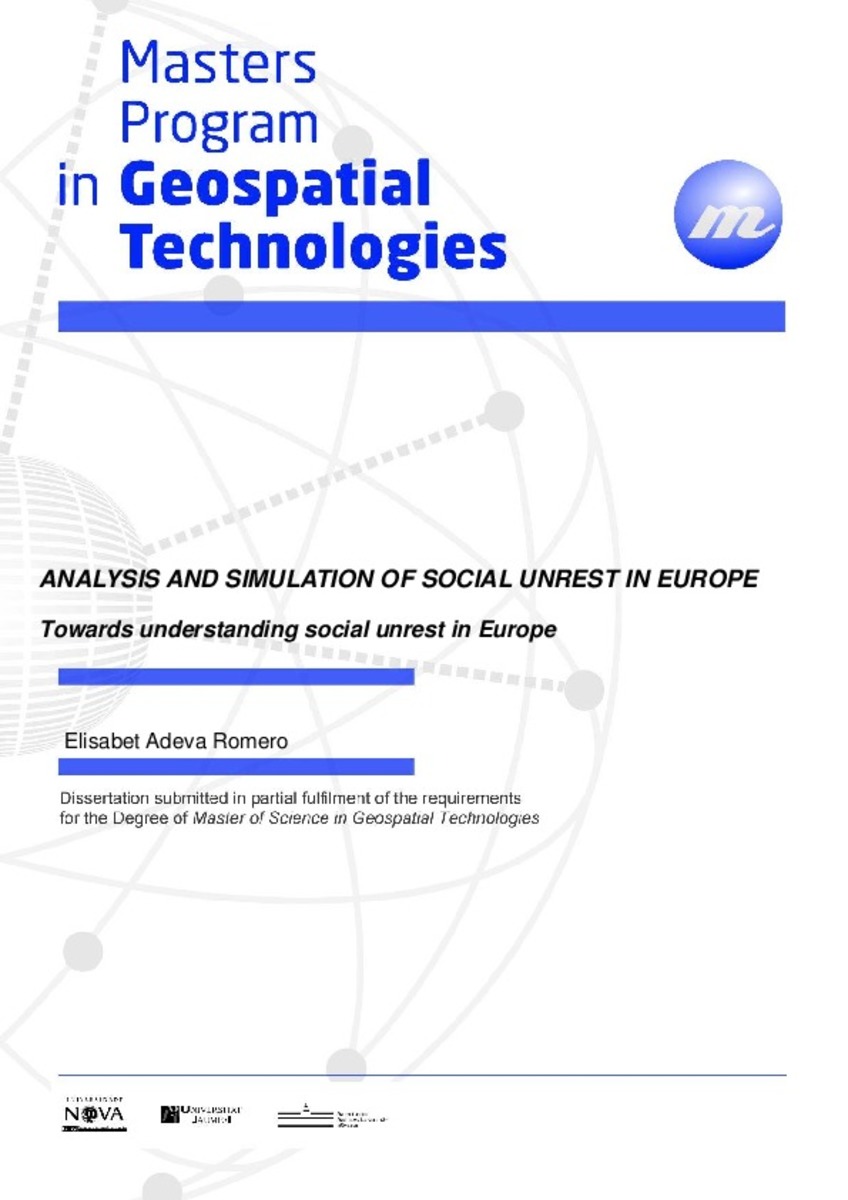Mostrar el registro sencillo del ítem
Analysis and simulation of social unrest in Europe. Towards understanding social unrest in Europe
| dc.contributor | Mateu, Jorge | |
| dc.contributor | Costa, Ana Cristina | |
| dc.contributor | Pebesma, Edzer | |
| dc.contributor.author | Adeva Romero, Elisabet | |
| dc.contributor.other | Universitat Jaume I. Departament de Matemàtiques | |
| dc.date.accessioned | 2016-04-18T06:52:49Z | |
| dc.date.available | 2016-04-18T06:52:49Z | |
| dc.date.issued | 2014-02 | |
| dc.identifier.uri | http://hdl.handle.net/10234/158825 | |
| dc.description | Treball Final del Màster Universitari Erasmus Mundus en Tecnologia Geoespacial (Pla de 2013). Codi: SIW013. Curs acadèmic 2013-2014 | ca_CA |
| dc.description.abstract | Protest of Europe from 2000 to 2010 where analyzed to foster understanding of the distribution and behaviour of those during the time mentioned. The main object of this study was to discover the relation with variables available in Eurostat and discover the pattern of those protests around Europe. Ordinary Least Squared Method and Spatial point pattern analysis methods were implemented in the R software environment for this purpose. Overall, the variables selected do not define the protests behaviour but some of them are related and increase with the protests. Protest tend to increase occur mostly when other protest have happened. Protest tend to create hotspots within Europe, their location are mostly in urban areas and close to the borders with other European countries. Resulting models discovered that protest/event distribution does not imitate to a Poisson process, and that their behaviour can be better described by interaction between protests. The final model chosen by best distance was analyzed for Europe and later for Germany, France, United Kingdom and Spain due to an unequal distribution of protests in Europe; a further temporal analysis was computed only for Spain. The set of models computed, showed that protest location are scattered within the European megalopolis, and reveals characteristics the attraction to some capitals so that clustered or hot spots pattern are observed. This analysis is one of the first analyses prepared by the recently launched, Global Database of Events, Language, and Tone (GDELT), a big free online data base of over 250m events and 300 categories from riots and protests to diplomatic exchanges and peace appeals codified from world news sources. From this analysis we recommend that further models could be applied to compute dissemination and contagions over time within borders. | ca_CA |
| dc.format.extent | 95 p. | ca_CA |
| dc.format.mimetype | application/pdf | ca_CA |
| dc.language.iso | eng | ca_CA |
| dc.publisher | Universitat Jaume I | ca_CA |
| dc.rights | Attribution-ShareAlike 4.0 Spain | * |
| dc.rights.uri | http://creativecommons.org/licenses/by-sa/4.0/ | * |
| dc.subject | Màster Universitari Erasmus Mundus en Tecnologia Geoespacial | ca_CA |
| dc.subject | Erasmus Mundus University Master's Degree in Geospatial Technologies | ca_CA |
| dc.subject | Máster Universitario Erasmus Mundus en Tecnología Geoespacial | ca_CA |
| dc.subject | protest | ca_CA |
| dc.subject | GDELT (Global Database of Events, Language, and Tone) | ca_CA |
| dc.subject | Spatial Autoregressive model | ca_CA |
| dc.subject | Spatial Point Pattern Analysis | ca_CA |
| dc.subject | Spatial distribution pattern | ca_CA |
| dc.subject | spatstat | ca_CA |
| dc.title | Analysis and simulation of social unrest in Europe. Towards understanding social unrest in Europe | ca_CA |
| dc.type | info:eu-repo/semantics/masterThesis | ca_CA |
| dc.educationLevel | Estudios de Postgrado | ca_CA |
| dc.rights.accessRights | info:eu-repo/semantics/openAccess | ca_CA |
Ficheros en el ítem
Este ítem aparece en la(s) siguiente(s) colección(ones)
-
TFM: Màster Universitari Erasmus Mundus en Tecnologia Geoespacial [79]
SIW013; SIK013








